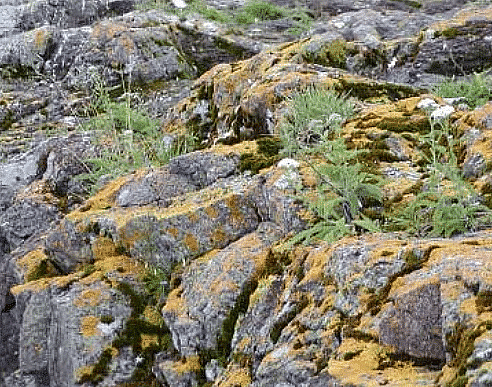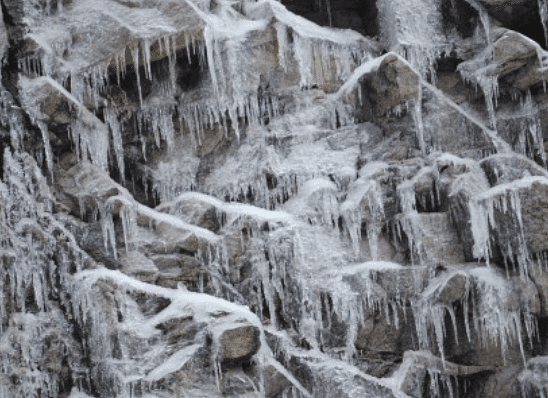ACT Exam > ACT Notes > Science for ACT > Weathering
Weathering | Science for ACT PDF Download
| Table of contents |

|
| Introduction |

|
| What are the Three Types of Weathering? |

|
| What is Chemical Weathering? |

|
| What is Mechanical Weathering? |

|
| Can Humans Influence Weathering? |

|
Introduction
- Weathering refers to the process of breaking down or dissolving rocks at the Earth's surface, contributing to the erosion of coastlines and the gradual wearing away of exposed surfaces.
- Various types of rocks exhibit differing susceptibility to weathering. Additionally, weathering initiates the formation of soils, as rocks' sharp edges are smoothed and reduced in size. These weathered particles, often combined with organic matter such as plant debris, animal remains, and microbial activity, give rise to soil formation. While soils derived from a single type of weathered rock tend to be infertile, those originating from a mixture of weathered materials from different rocks typically yield more fertile soil.
 5 Facts About Weathering
5 Facts About Weathering
- Weathering should not be confused with erosion. Erosion describes the moving of rocks via water, wind or gravity, whereas weathering describes the breaking down of rock through direct contact.
- There are three types of weathering: biological, chemical, and mechanical.
- Rain is actually mildly acidic, and therefore slowly eats away at rocks - this is an example of chemical weathering.
- Plants and animals also cause rocks to erode - this is an example of biological weathering.
- Water can seep into the cracks of rocks, as the temperature cools and this water freezes, this causes rocks to break away - this is mechanical weathering.
What are the Three Types of Weathering?
Any exposed rocks along the coastline can be broken down by the three types of weathering.
The three types of weathering are:
- Mechanical weathering
- Chemical weathering
- Biological weathering
What are Weathering Agents?
- There are various different weathering agents. Weathering agents are the things that contribute to the process of weathering. Water, ice, acids, salts, plants, animals, and changes in temperature are all agents of weathering.
What is Biological Weathering?
- Biological weathering is the weakening and wearing away of rock by plants, animals and microbes. For example, plant roots can enter a small crack in a rock and then as the root grows larger the crack in the rock gets larger. This weakens the structure of the rock until it eventually breaks away.
What is Chemical Weathering?
- Chemical weathering refers to the alteration of the molecular structure of rocks and soils, leading to their weakening and eventual erosion.
- This process often occurs due to the presence of slightly acidic substances like rain or saltwater. Coastal regions, where rocks such as limestone or chalk are prevalent, are particularly susceptible to chemical weathering, as the acidity in the water gradually dissolves these rocks over time.
- For instance, carbonic acid, despite being a weak acid, is highly effective at dissolving limestone. When carbonic acid infiltrates limestone underground, it can create substantial cracks or even form numerous small caves.
- Another form of chemical weathering involves rocks containing iron, which undergo rusting through oxidation. Rust formation transpires through the interaction of oxygen and iron with water. As rust expands, it weakens the rock, eventually leading to its fragmentation.
What is Mechanical Weathering?
- Mechanical weathering, also known as physical weathering, involves the gradual disintegration of rocks. Water plays a crucial role in mechanical weathering, along with fluctuations in temperature. One prominent mechanism of mechanical weathering is freeze-thaw weathering.
- In freeze-thaw weathering, rocks with pores, also known as porous rocks, allow water to permeate through them. When water seeps into cracks within the rock and subsequently freezes as temperatures drop below freezing, it expands, widening the crevices. As the ice melts with rising temperatures, the water penetrates deeper into the rock crevices. This cycle repeats continuously until the rock eventually disintegrates completely.
- Another form of mechanical weathering is thermal stress, where changes in temperature cause rocks to expand and contract repeatedly. This expansion occurs in heat and contraction in cold, gradually weakening the rock with each cycle. This phenomenon is especially common in regions like rocky deserts, where temperatures fluctuate significantly between day and night.
- Additionally, porous materials like clay, when in proximity to rocks, can contribute to mechanical weathering. Clay absorbs water and expands, exerting pressure on the surrounding harder rock and causing erosion. Salt is another agent that affects weathering; saltwater infiltrating cracks or crevices in rocks can leave behind salt crystals as the water evaporates. These crystals then grow, exerting pressure on the rock and eventually leading to its fragmentation.
- Clay minerals, such as quartz, are among the most common by-products of weathering, particularly chemical and physical weathering. Clay accounts for approximately 40% of the composition of all sedimentary rocks on Earth.
- Animals also act as agents of weathering. Creatures dwelling underground, like moles, may contribute to the disintegration of rock and soil. Moreover, animals that dig or trample above-ground rocks can cause them to crumble or break away.
Can Humans Influence Weathering?
- Although weathering is a natural process, human activities can accelerate it. One significant example is air pollution, which can expedite weathering by releasing chemicals into the atmosphere through the burning of fossil fuels like natural gas and coal. These chemicals subsequently form acids that fall back to Earth as acid rain.
- Acid rain has detrimental effects on rocks such as limestone and marble, damaging buildings, monuments, and even gravestones.
Understanding Weathering, Erosion, and Deposition
- Weathering, erosion, and deposition are interrelated processes that have shaped the Earth's surface over billions of years. They constitute a continuous cycle of geological transformation.
- Weathering involves the breakdown of rocks by various agents such as water, ice, wind, animals, and plants.
- Erosion entails the movement of material, known as sediment, resulting from the breakdown of rocks. This sediment comprises rocks, minerals, and organic remains, and erosion agents include water, ice, wind, and gravity.
- Deposition refers to the settling of sediment in new locations. Examples of deposition include the formation of islands or sand dunes.
- These processes collectively contribute to changes in the shape and composition of landforms, such as mountains, beaches, and riverbeds, over time.
The document Weathering | Science for ACT is a part of the ACT Course Science for ACT.
All you need of ACT at this link: ACT
|
485 videos|520 docs|337 tests
|
FAQs on Weathering - Science for ACT
| 1. What are the Three Types of Weathering? |  |
Ans. The three types of weathering are mechanical weathering, chemical weathering, and biological weathering.
| 2. What is Chemical Weathering? |  |
Ans. Chemical weathering is the process in which rocks and minerals are broken down by chemical reactions, leading to changes in the composition of the material.
| 3. What is Mechanical Weathering? |  |
Ans. Mechanical weathering is the process in which rocks and minerals are broken down into smaller pieces without any change in their chemical composition, often due to physical forces such as water, wind, or temperature changes.
| 4. Can Humans Influence Weathering? |  |
Ans. Yes, humans can influence weathering through activities such as mining, construction, and deforestation, which can accelerate both mechanical and chemical weathering processes.
| 5. How does Weathering impact the environment? |  |
Ans. Weathering can impact the environment by altering the landscape, releasing nutrients into the soil, and contributing to the formation of sedimentary rocks. It can also lead to soil erosion, which can have negative effects on ecosystems and water quality.
Related Searches




















